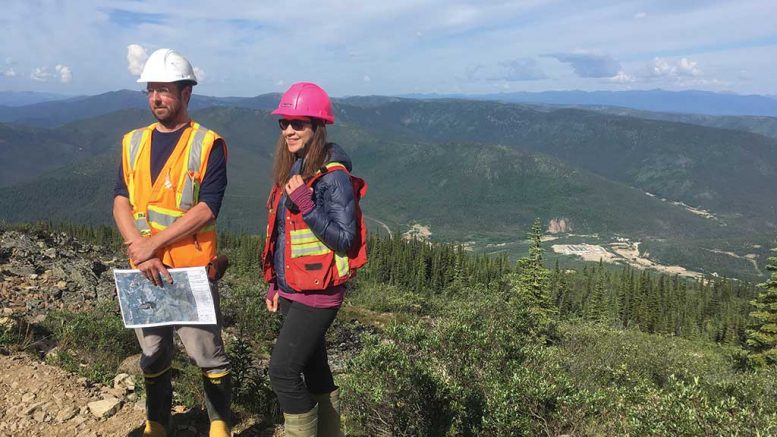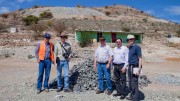DAWSON CITY, YUKON — Most geologists wouldn’t even strike a hammer against the discovery outcrop for Victoria Gold’s (TSXV: VIT; US-OTC: VITFF) Eagle gold deposit, 49 km northeast of Mayo, Yukon. The granitic rock face jutting out of a road cut has little more than a few thin veins going through it, providing little indication of the 4 million oz. gold entombed below.
It’s why countless gold panners and explorers who trudged through the area for more than a century kept largely to the rivers that incise the valley. Over 150,000 oz. placer gold was recovered, enough to establish its reputation as one of the most productive placer drainages in the Yukon.
Now, almost three decades since Eagle’s discovery, Toronto-based Victoria Gold is well on its way of putting the deposit into production, having secured a US$220-million facility in July to build the mine.
As construction unfolds, the aspiring miner has returned some attention to exploration, uncovering what appears to be a flock of Eagle-like deposits over a 30 km strike length called the Potato Hills trend.
“We’re not just a one-trick pony — there’s more here than just Eagle,” Paul Gray, Victoria’s vice-president of exploration, tells a group of investors and writers, including The Northern Miner, while standing over the discovery outcrop during a site visit in July. “We’re looking at targets that can add meaningfully to the proposed mine life at Eagle … I want to find grade, anything a gram and a half on surface.”

Location map of Victoria Gold’s Eagle gold project and major projects in central Yukon. Credit: Victoria Gold.
With the knowledge gained from 80,000 metres of drilling at Eagle, Victoria has revised its exploration model to generate targets across its 555 sq. km Dublin Gulch property.
Gray says the deposit, which is analogous to Kinross Gold’s 8 million oz. Fort Knox gold mine in Alaska, is “geologically boring, but mineralogically consistent,” occurring as spiderwebs and sheets of veins crosscutting a 100-million-year-old intrusive.
But geophysical and geochemical surveys conducted by Eagle, along with reinterpretations of historical data, have cast a spotlight on the edges of the intrusive and where it meets the surrounding bedrock.
It’s along those boundaries that Victoria has found a series of higher-grade, shear-hosted gold and silver systems, many of which were exploited historically with old shafts and adits.
This year, the company has spent $12.5 million building over 50 km of access roads, excavating 6 km of trenches and carrying out 35,000 metres of drilling, including 3,000 metres to extend the Eagle deposit to depth.
The regional exploration campaign is the largest of its kind on the property in over a decade.

Paul Gray, Victoria Gold’s vice-president of exploration, at the Eagle discovery outcrop in central Yukon. Photo by Lesley Stokes.
“We’re really digging into the data and applying our knowledge with the new exploration model,” Gray says. “We’re also investing into the future by upgrading the old cat trails to gain better access into what we believe is a property with district-scale potential.”
The most advanced target is the Olive-Shamrock deposit, 2 km northeast of Eagle, which saw 5,000 metres of extension drilling this year. Key drill highlights from Olive — released on Sept. 11 — include 33 metres of 1.54 gram gold per tonne and 9.1 metres of 3.14 grams gold, while drilling at Shamrock intercepted 40 metres of 1.04 grams gold, and 23 metres of 2.78 grams gold.
“Most of the focus over the last couple of seasons has been on Olive-Shamrock. We’re trying to define a satellite deposit that could be brought into years seven or eight of Eagle’s mine plan,” Gray says. “The deposit is higher-grade, and a different style than Eagle, but metallurgically it’s similar and could be processed under the same roof.”
Olive-Shamrock has 10 million measured and indicated tonnes of 1.07 grams gold for 329,000 oz. gold, and 7 million inferred tonnes of 0.89 gram gold for 210,000 oz. gold.
The other targets along the Potato Hills trend are the Catto Zone, Bluto, Spinach and Popeye — to name a few — and the company has already begun delivering a steady flow of drill results. Most of the targets have seen limited to no drilling, and have accompanying geochemical or geophysical anomalies.

Drill core from exploration drilling at Victoria Gold’s Dublin Gulch property, central Yukon. Credit: Lesley Stokes.
At Popeye, 3 km northeast of Eagle, drilling returned 4.3 metres of 46.63 grams gold from 23 metres deep, while at Spinach, 500 metres south of Olive-Shamrock, the best intercept returned to date is 5 metres of 4.26 grams gold.
Victoria also uncovered a 6-metre long, heavily fractured quartz vein near the headwaters of a creek while trail blazing into the Bluto target, 6 km east of Eagle. Trench sampling there returned 146 metres of 0.67 gram gold, including 14 metres of 4.87 grams gold along the vein.
For John McConnell, Victoria’s president and CEO, drilling this year proved to be an “exciting” time for the company.
“We continue to add ounces at Olive and Shamrock. There are half a million ounces in the resource and I’m sure we could double or triple that. Another new area is Catto, the grade is good. It doesn’t look like it will be really big, but it’s right on surface and it will add more ounces,” he said during a follow-up interview with The Northern Miner in November. “And Bluto is our top exploration target. We’ve outlined a 2 by 1 km geochemical and geophysical anomaly there and it’s never been drilled before, so we’re excited to get back in March and see what’s there.”
The most appealing part of the program, he said, was drilling the Eagle Deep target, where mineralization was found for another 400 metres below the deposit’s 2016 feasibility pit boundary.
“With the four holes we’ve completed, we’ve shown there are another 400 metres of open-pittable material under the right economic conditions,” McConnell said. “It could extend the planned mine life from 10 to 20 years, or you could increase production to 300,000 oz. for 15 years.”
One of the drill holes from the program was mineralized for its entire length, returning 624 metres of 0.50 gram gold. Other intercepts included 371 metres of 0.65 gram gold from 186 metres, and 37 metres of 1.27 grams gold from 250 metres.
Extension drilling along the under-tested, northern flank of Eagle also found near-surface gold mineralization, with results of 21 metres of 0.64 gram gold from 50 metres.
McConnell says that exploration drilling will resume in March, but he doesn’t expect the company will update the project’s resource estimate in the near future. Instead, the company wants to fine-tune its exploration model and lighten the blue-sky potential at Eagle beyond its planned mine life.
Victoria is scheduled to process 33,700 tonnes per day at Eagle over a 10-year mine life with a 0.95-to-1 strip ratio.
The US$280-million heap leach mine would produce 190,000 oz. gold per year at an operating cost of US$539 per oz. gold.
Victoria has spent $40 million on earthworks and preparing the site for the second phase of construction to begin by year-end.
But first, Victoria must secure the remaining US$60 million to cover initial building costs.
“We’re looking at convertible debt, equity, talking to all the royalty and streaming companies, a gold loan facility or bringing in another strategic investor like a major to fill that funding gap, but the game is more on equity,” he said. “We won’t do a bad deal — minimizing dilution of our existing shareholders is the goal.”






Be the first to comment on "Site visit: Victoria explores the blue sky at Eagle"